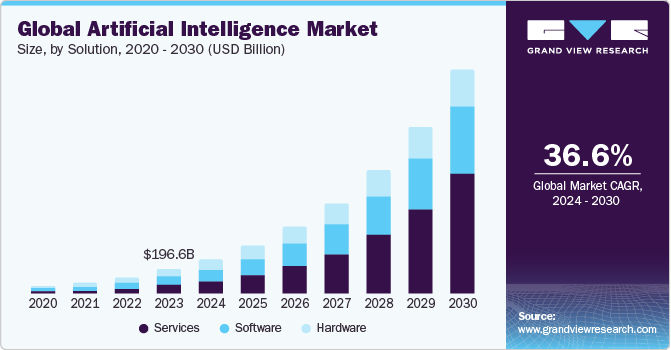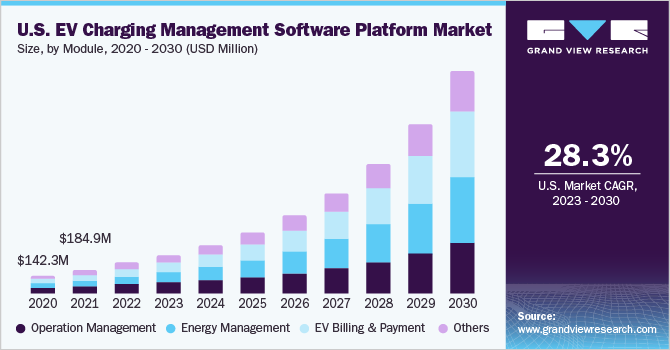- AI is becoming core infrastructure, not just a buzzword, cloud giants are investing tens of billions into custom chips and AI-native services to meet soaring enterprise demand.
- Cloud is the silent backbone of the AI revolution, enabling scalable, secure, and modular deployment of AI applications across industries, with hyperscalers leaning into vertical-specific compute models.
- EVs are evolving into software-first platforms, where the real edge lies in onboard intelligence, real-time data processing, and vertical integration, not just in batteries or range.
- The convergence of AI, cloud, and EVs is the real story, creating a compounding ecosystem where data, compute, and mobility fuel each other, reshaping infrastructure and redefining winners in the digital economy.
TradingKey - Artificial intelligence is no longer just about neat demos or language model fracases, the AI revolution is fast becoming the underpinning of world infrastructure. Behind the scenes, enterprise adoption is going into full throttle. Every big cloud provider, from AWS to Azure to Google Cloud, is going all-in on GPUs, custom silicon, and AI-native services. These are not marketing forays; they're core capex commitments, the tens of billions of dollars being invested into AI-specific architecture to handle what is fast becoming generational demand.
This spending wave is not speculation. AI workloads, from training ground-level models to edge inferencing, require tremendous compute density. Semiconductors, networking, power optimization, and AI-native cloud software form a layered stack, each allowing for a different monetization path. Infrastructure stalwarts that have genuine moats, whether engineered into the building of the data center, into chip design, or into deployment agility, are self-sorting from the pack. The market has acknowledged, valuing most of these names on premium multiples, but where earnings compounding still might be underpricing that premium could very well become the new baseline.
That which differentiates the winner from the crowd is no longer access to capital or spin of marketing, but scale-based operational leverage. Taking AI and turning that into predictable, high-margin revenue across verticals like security, healthcare, and enterprise software is where the real proof is. And that’s where the cloud meets AI.

Source: grandviewresearch.com
Cloud: But the Silent Kingmaker
Behind all of the AI hype, the unsung hero of the equation is still cloud infrastructure. All AI models, applications, and services need somewhere to call home, and that home must scale, have low latency, security, and modularity. Cloud is not the AI sidekick, but rather the AI operating system. Even as the cloud growth narrative has reached maturation for investors’ minds, economics remains favorable. Gross hyperscaler margins can easily exceed 65%, and bundling AI service along with storage, compute, and database services enables sticky customer relationships along with revenue per user growth.
Cloud vendors are exiting general-purpose compute into AI-specialized verticals. Custom chips, co-location, and sovereign cloud zones all revolve around the final purpose of hosting AI-native applications at scale. All of that is needed because Enterprise AI of the future is going to be very context-specific, logistics, finance, biotech, you name it, where each case needs a different deployment model. Whoever cracks performance and scale wins the battle for the enterprise AI budget.
The synergistic feedback loop holds: more applications of AI stimulate more use of the cloud, and more use of the cloud injects still more data into training pipes, which improves AI usability. This flywheel creates an environment where a handful of vendors can gain dominance of spend on infrastructure over multiple decades. Investors invariably undervalue the duration of these cycles. Today's AI-cloud cycle might still be in its initial innings.
.jpg)
Source: grandviewresearch.com
Electric Vehicles: From Hardware to Smart Platforms
The EV sector has moved way past its “hype-versus-reality” phase. Adoption curves are becoming steeper, global infrastructure is expanding, and governments remain fixed on decarbonization objectives even as they grapple with short-term political volatility. What everyone tends to miss, though, is that the narrative of EVs has moved past battery chemistry or range anxiety. It is software, of edge intelligence, and ecosystem leadership.
A modern electric car is an on-wheel computer node. As connectivity stacks, processors, and onboard sensors are increasing, the modern-day EV is becoming a device amenable to decision-making in real time that is data-intensive. It is for that very reason that those companies that pair together EV hardware with vertically integrated stacks of software, as illustrated by the Tesla, Rivian, or even BYD model, command margin and mindshare. Generalist automotive OEMs play catch-up, and they normally outsource their layer of intelligence to externals, creating even more bifurcation of profitability.
Moreover, the business case for EVs is quickly shifting from environmental purity to hard dollar-and-cents economics. Cost of ownership is becoming lower due to rapidly declining battery costs and rising fuel prices, and commercial fleets are reaching five-year break-evens on mass-scale EV adoption. It makes the question less “if” and more “how soon,” and those who have scale in manufacturing, intelligent routing software, and energy management capacity are going to own the coming decade.
Notably, the EVs also close the loop back to AI and cloud. Features such as predictive maintenance, real-time route determination, and autonomous driving modules also involve extensive integration into data infrastructure as well as training models. As such, the EV market is expected to grow significantly in the following years and thereby be represented as the front-end data generator of AI-backend systems based on the cloud.

Source: grandviewresearch.com
The Compound Effect: All Three Themes Interacting Together
AI, cloud, and EVs are not separate silos but are part of an overall narrative of convergence. AI applications are accelerated by cloud platforms. Cloud growth is fueled by the resulting data that is generated at the edge, including smart vehicles. EV intelligences, in conclusion, are powered by cloud-native AI platforms.
This cycle of feedback is why these three themes are far more potent as a group than they are individually. Investors who consider them together risk losing out on the compounding magic of their intersection. This is not just an upgrade cycle of tech – it’s an overhaul of the world’s platforms. Infrastructure is being re-written, workflows re-engineered, and end-markets redefined. Winners won’t just sell a faster chip, cleaner car, or cheaper cloud server – they’ll sell a flywheel that scales across all three.
However, such convergence comes along with risks. Higher valuations of AI and cloud peers look ahead but not to current fundamentals. AI data-center use of power can get limited politically as well as environmentally. And EV demand, fundamentally sturdy as it is, can get distorted by changing incentives or commodity volatility.
But the structural demand drivers, the digitization, decarbonizing, and automation of industries, all line up. That makes the notion of short-term corrections more about rotation rather than reversal of trend. For investors, the problem is identification of platforms capable of surviving volatility, compounding value through integration across each of the three megatrends.
.jpg)
Source: reuters.com
Conclusion: Investment in Smart Infrastructure
AI-Cloud-EV is no longer speculation. It is the theme of the coming economic supercycle. Supporting each other, they create an exponential growth lattice of possibilities. Hype cycles, yes, but underneath, an underlying change that is real, and only just started.
Their most convincing opportunities lie not where they can chase hype but where they have scale, infrastructure, and operating leverage to dominate their vertical and bleed into adjacent ones. Investors have to look beyond skin-deep, draw charts where these megatrends cross, and back the platforms that are going to become the victors of that intersection into the 2030s.


